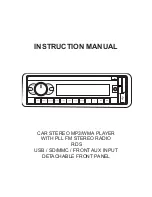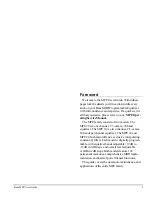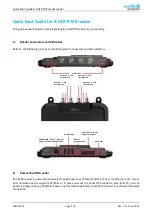
CONTROLS & FUNCTIONS
EFFECTS SECTION
_____________________________
AMICO 10 USB features an effect section with a digital audio signal
processor that can simulate the sounds of any acoustic
environment. Its 99 different effects allow to add special sound
characteristics to the direct signals passing through mixer
channels.
Mon:
for adjusting the quantity of effect return signal to be sent to
the MON jack output.
Eff Snd:
for controlling the general signal level to be sent to the
SEND jack output and to the return effect input.
Pgm:
the display will show the number of the selected programme;
to select and confirm use the «PRESS TO SEL» selector switch.
Tap:
the TAP button sets the desired repetition time according to
the music rhythm; the last setting is stored when the system is
turned off.
Vol:
volume control of the effect sent to the MAIN L/R outputs.
Mute:
for switching the channel on/off.
Peak:
the PEAK LED indicates signal peak level. It lights up when
the effect output signal is slightly below the saturation point.
BACK PANEL
Send / Return:
the effect send signal to be connected to the
external effect input is in the SEND jack socket. Its level is
controlled by the EFF SEND potentiometer.
The RETURN L/R jack sockets allow to connect the external effect
output to the mixer, simultaneously bypassing the internal effect.
Foot SW.:
mono jack socket for connecting a remote control which
enables/disables the internal effect.
00-02
03-05
06-07
08-09
10-12
13-15
16-18
19
20-26
27-29
30-35
36-39
40-43
44-47
48-49
50-58
Small Hall
Mid Hall
Big Hall
Church
Small Room
Mid Room
Big Room
Cathedral
Plate
Spring
Gated Rev.
Reverse
Early Refl.
Ambience
Stadium
Delay
59.
60-65
66-69
70-73
74-79
80-81
82-83
84-85
86-87
88-89
90
91
92-93
94-95
96-97
98-99
Echo
Chorus
Flanger
Phaser
Pitch Shift
Chorus & Rev
Flanger & Rev.
Pitcher & Rev
Pitch & Rev.
Delay & Re
Delay & Gated
Delay & Reverse
Delay & Chorus
Delay & Flanger
Delay & Phaser
Delay & Pitch
Program Chart
SMALL HALL / MID HALL / BIG HALL
HALL programmes represent the real emulation of great concert halls
where musicians are located on stage in the middle of a big sound-
reflecting environment. HALL programmes allow to merge in a
homogeneous mix the different instruments coming from the single
channels, thus creating an extremely real environment around them.
These programmes are perfect for single voices, choruses and acoustic
instruments.
CHURCH
The reverb of a church with plenty of late reflections.
ROOM
ROOM programmes reproduce the environment of mid-size acoustic
concert halls, characterized by special sound colours due to the reflecting
walls that can generate several reflections. These environments are for
example «music clubs», lounges and rehearsal rooms, where the effect
fades slightly fast but maintains a good clearness and intelligibility for the
original signal. ROOM programmes are especially suitable for cinema and
television, as well as for rhythm and accompaniment instruments.
CATHEDRAL
Long and narrow reverb of a great cathedral, suitable for instrumental solos
or voices of lentos.
PLATE
The PLATE reverb was originally obtained with a thin, spring-suspended
metal sheet that was forced to vibrate by a transducer modulated by an
audio signal. The result on the sound transmitted through PLATE was that
of a sound coming from a vast open space. PLATE programmes
synthesize the sound of metal plates with initial high diffusion and a
relatively bright and coloured sound. These programmes are designed to
be used as a part of the music, by softening and thickening the original
sound; they are very common in pop music and particularly in percussions.
SPRING
for simulating the classical reverb of a spring.
GATED REV.
This effect represents a reverb artificially cut-off and was made famous by
the song «In the air tonight» by Phil Collins.
REVERSE
A reverb where the envelope curve is reverted, i.e. the volume is initially low
and then rises.
EARLY REFL.
This reverb is characterized by very marked early reflections and is
specially suitable for dynamic signals (drums, percussions, slap-bass,
etc.).
AMBIENCE
This reverb programme simulates a mid-size room without late reflections.
DELAY
DELAY is an effect used to change the sound of electric or amplified
musical instruments. Sometimes it is also improperly referred to as
«echo». The DELAY general function is that of recording an incoming
sound and playing it with a preset time delay. Generally the delayed sound
is added to the original signal instead of substituting it; in this case the
overall effect is similar to that of the echo.
ECHO
The ECHO effect electronically generates delays at regular intervals for
deeper and wider sounds.
CHORUS
This effect adds a slight frequency variation to the original signal; therefore,
together with TREBLE variation, produces a pleasant suspended sound
effect. The CHORUS effect is so often used for signal diffusion in so many
different ways that any recommendation about containing its use would be
vain. The modulation rate is from slow to fast CHORUS effect.
FLANGER
FLANGER is an electronic audio effect obtained through the use of a delay
line - with considerably long times – through which the signal to be treated
passes. The delayed signal is then mixed with the original signal provoking
the erasure of opposite phase frequencies. The resulting sound features
resonance peaks and points with no audio signal; the effect is
evanescence on the whole sound spectrum, just like the noise of a jet plane
passing nearby.
PHASER
The PHASER operating principle is that of adding to the audio signal a
second out-of-phase signal. The sound material thus becomes thicker and
above all more vital. This effect has been vastly used for songs with guitars
and keyboard surfaces but, during the seventies, was massively
introduced also for other instruments such as, for example, the electronic
piano.
PITCH SHIFT
With respect to the played notes, this effect generates secondary notes
with the tonality decided by the musician thus producing harmonies.
CHORUS & REV
This effect mixes CHORUS with a reverb whose length depends on the
programme.
FLANGER & REV
Reverb and FLANGER effect combined together.
PITCH & REV
The PITCH SHIFTER slightly changes the signal frequency, while the
reverb adds a spatial effect.
DELAY & REV
DELAY and reverb, the most frequent combination for singing, guitar solos,
etc.
DELAY & GATED
The combination of ECHO and GATE effects to obtain a short and «sharp»
sound suitable for percussion instruments.
DELAY & CHORUS
While the CHORUS contributes to signal diffusion, the DELAY sets
interesting repetition effects. For instance a marked effect can be added to
the singing, without the voice sounding too much drowned.
DELAY & FLANGER
Effect suitable for creating a singing sound in line with the times and with a
futurist, «spacig» effect.
DELAY & PHASER
This effect puts a mono DELAY and a mono PHASER in parallel.
DELAY & PITCH
A repetition of the audio signal to which the PITCH SHIFTER adds a
pleasant suspended sound effect.
10
Summary of Contents for AMICO 10 USB
Page 8: ...DIMENSIONS 6 SUPPLIED ACCESSORIES ...
Page 10: ...MONO SECTION STEREO SECTION EFFECT SECTION MASTER SECTION SUPPLY AND POWER SECTION 8 ARTWORK ...
Page 18: ...THE AMICO SYSTEM IN VARIOUS APPLICATIONS 16 ...
Page 19: ...THE AMICO SYSTEM IN VARIOUS APPLICATIONS 17 ...
Page 20: ...TECHNICAL SPECIFICATIONS 18 ...
Page 21: ......







































